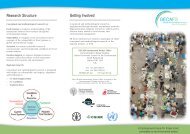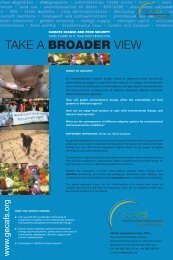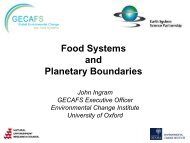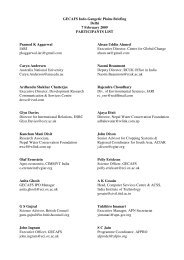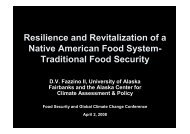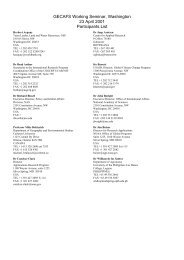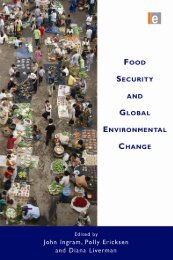Institute for Meteorology and Hydrology (CIMH)); social and natural scientists from national researchinstitutions (e.g. universities and national labora<strong>to</strong>ries); policy-makers from regional agencies (e.g. theCaribbean Community Secretariat (CARICOM), Inter-American Institute for Cooperation onAgriculture (IICA)); policy-makers from national agencies (e.g. Ministries of Agriculture);international agencies (e.g. FAO, UNEP); and was facilitated by the GECAFS scenarios group. Anumber of key steps were involved:1. Identifying key regional GEC and policy issues, based on an initial stakeholder consultationworkshop involving regional scientists and policy-makers.2. Drafting a set of four pro<strong>to</strong>type regional scenarios (<strong>Global</strong> Caribbean, Caribbean Order fromStrength, Caribbean TechnoGarden and Caribbean Adapting Mosaic) in a first regional workshop,which were then elaborated upon in a follow-up writing exercise by regional authors. These werebased on the broad rationale, assumptions and outcomes of the MA scenarios exercise, butallowing for regional deviation where needed.3. Describing developments per scenario for key aspects of the food system, the focus of a follow-upregional workshop involving most of the first regional workshop participants.4. Systematically assessing food system developments per scenario, and presenting outputsgraphically as part of a second regional workshop. This involved describing the maindevelopments per scenario for each <strong>Food</strong> <strong>Security</strong> element, systematically assessing eachdevelopment per scenario for each food security element, and finally plotting each assessment(see Figure 1).The scenario exercise delivered a number of related outputs: it integrated (i) improved holisticunderstanding of food systems (axes on graphs) with (ii) vulnerability (change of position along axes)with (iii) policy interpretation of future conditions (comparing four graphs) with (iv) adaptationinsights at the regional level for improving overall food security (where <strong>to</strong> concentrate effort onenlarging the polygon areas of each graph).Figure 1 Indicative food security diagrams for four Caribbean scenarios (GECAFS, 2006b)96
Methodological challenges for research at regional levelResearch undertaken at the regional level embodies a number of methodological challengesthat need <strong>to</strong> be addressed at the outset, otherwise they become bottlenecks. In the biophysicalsciences, data collection takes place at specific geographical and physical locations, andtherefore at specific points in time. Given the spatial heterogeneity, or the spatial patterns, inmost biophysical parameters of relevance <strong>to</strong> food security and <strong>to</strong> the interactions betweenGEC and food security within a region, data needs <strong>to</strong> be collected using statistical methodsthat allow extrapolation from a relatively limited number of data points (relative <strong>to</strong> a wholeregion). For instance, measures of soil fertility – however a given project defines soil fertilityand its measures – need <strong>to</strong> be collected in such a way that the heterogeneity of soil fertility atthe subregional/watershed level is captured, and extrapolation of the measures <strong>to</strong> a regionalpicture of soil fertility is feasible and meaningful. This is, in itself, not a straightforwardexercise. Methods have been developed <strong>to</strong> conduct such data collection and analyses ofspatial patterns across regions, for instance using geostatistics (Coe et al., 2003).In food security and GEC studies, this is, however, complicated by the fact that other systemparameters within a region (e.g. farmers’ access <strong>to</strong> roads and markets) also vary, but at adifferent spatial level. As a rule, spatial patterns in biophysical and socio-economicparameters within a region occur over different levels on both spatial and temporal scales.Since the data collected will have <strong>to</strong> be analysed in an integrated manner <strong>to</strong> arrive at ameaningful and useful picture of GEC/food security interactions within a region, a ‘silo’ typeof analysis, in which biophysical data are analysed separately from socio-economic data, isnot a feasible option.To enable researchers <strong>to</strong> conduct a scientifically robust integrated analysis of all the datacollected, as is essential in GEC/food security studies, a geographical unit of analysis, whichis meaningful from both a biophysical and a socio-economic perspective, needs <strong>to</strong> beidentified by the scientists involved. In the ASB programme, for instance, the scientistsfinally agreed upon a set of ‘land use categories’ that were used throughout all the ASBbenchmark sites, and that were essential in the extrapolation of the data collected <strong>to</strong> regions.In the GECAFS work in the Indo-Gangetic Plain, the agreed unit of analysis for each casestudy was an administrative district.In addition <strong>to</strong> these requirements for data collection and integrated analysis of data at theregional level, methods capable of investigating interrelationships among different types ofanalysis and capable of synthesizing and analysing the key economic, environmental,agronomic and biophysical issues at stake, and at the correct resolutions, are also needed. Arange of models and mathematical methods exist that provide relevant <strong>to</strong>ols for this, but allhave limitations of course (Coe et al., 2003); van Ittersum and Wery, 2007). Scientistsconducting GEC/food security studies thus need <strong>to</strong> carefully select the most appropriate <strong>to</strong>ols,given the specific objective of their research.97
- Page 1 and 2:
From Food Production to Food Securi
- Page 3 and 4:
From Food Production to Food Securi
- Page 5 and 6:
Table of ContentsAbstract .........
- Page 7 and 8:
Paper 6: Undertaking Research at th
- Page 9:
AbstractFood security is a conditio
- Page 12 and 13:
2010 about 925 million people had t
- Page 14 and 15:
water) are used, and reduce negativ
- Page 16 and 17:
While the flow of the argument abou
- Page 18 and 19:
determine interactions along and be
- Page 20 and 21:
Paper 3: A Food Systems Approach to
- Page 23:
From Food Production to Food Securi
- Page 26 and 27:
concerns and are now issues that mu
- Page 28 and 29:
the relationships between GEC and f
- Page 30 and 31:
Theme 2 aims to understand how comm
- Page 32 and 33:
GEC and the Food System of the Indo
- Page 34 and 35:
Paper 2: The role of agronomic rese
- Page 36 and 37:
These advances have resulted from a
- Page 38 and 39:
Crop selection to determine mechani
- Page 40 and 41:
Agronomic science is central to imp
- Page 42 and 43:
Agronomic research in relation to f
- Page 44 and 45:
The discussion above identifies a n
- Page 46 and 47:
interventions and political inertia
- Page 48 and 49:
While research on producing food ha
- Page 50 and 51:
Box 1 Food system Activities and fo
- Page 52 and 53:
In addition to broadening the debat
- Page 54 and 55:
options. Examples already seen rang
- Page 56 and 57: Figure 3 Outcomes for 10 variables
- Page 58 and 59: Figure 4 Nine ‘planetary boundari
- Page 60 and 61: Figure 5 Environmental change, food
- Page 62 and 63: Table 1: Indicative analysis of the
- Page 65: From Food Production to Food Securi
- Page 68 and 69: Trade Agreement (NAFTA) and the Eur
- Page 70 and 71: Parry et al., 2005). Conducting foo
- Page 72 and 73: is provided in the ESF/COST Forward
- Page 74 and 75: Paper 5: Engaging Stakeholders at t
- Page 76 and 77: into actions (strategies, policies,
- Page 78 and 79: Box 2 Engaging with stakeholders in
- Page 80 and 81: Box 3 Setting the research agenda f
- Page 82 and 83: Third, and of considerable practica
- Page 84 and 85: Figure 2: Organizing and understand
- Page 86 and 87: organizations made up of numerous n
- Page 88 and 89: Elements of good practice in stakeh
- Page 90 and 91: Finally, it is worth noting that fo
- Page 92 and 93: development (Lee, 1999; Gunderson a
- Page 94 and 95: Box 7 The GECAFS stakeholder survey
- Page 96 and 97: ‘break down’ what might be a hi
- Page 98 and 99: Paper 6: Undertaking Research at th
- Page 100 and 101: agriculture in many parts of the wo
- Page 102 and 103: gaps. The presence of a strong tech
- Page 104 and 105: an average of two years to coalesce
- Page 108 and 109: Identifying case study sitesResearc
- Page 110 and 111: can both benefit from and contribut
- Page 112 and 113: Box 5 Mapping stakeholder interests
- Page 114 and 115: Holding planning meetings in locati
- Page 116 and 117: This reorientation of the debate fr
- Page 118 and 119: Importance of this type of research
- Page 120 and 121: Integrating the food system concept
- Page 122 and 123: awareness of the GEC issues within
- Page 124 and 125: pollutants were then introduced as
- Page 126 and 127: communities operating in food syste
- Page 128 and 129: Improving input-use efficiency acro
- Page 130 and 131: governance focuses on the range of
- Page 132 and 133: Developing research agendas in supp
- Page 134 and 135: The renewed approach to interdiscip
- Page 136 and 137: BIELAK, A., HOLMES, J., SAVGÅRD, J
- Page 138 and 139: EAKIN, H. 2010. What is Vulnerable?
- Page 140 and 141: GODFRAY, H. C. J., BEDDINGTON, J. R
- Page 142 and 143: INGRAM, J. S. I. & FERNANDES, E. C.
- Page 144 and 145: LYUTSE, S. 2010. The One Billion To
- Page 146 and 147: RAYNER, S. & MALONE, E. L. 1998. Hu
- Page 148 and 149: UNDP 2006. The 2006 Human Developme
- Page 150 and 151: activities “from plough to plate
- Page 152 and 153: contribution to the science agenda:
- Page 154 and 155: urgently needed, and - given the gr
- Page 156 and 157:
GECAFS plannenmakerij stelde vast d
- Page 158 and 159:
ieder hun eigen groep van betrokken
- Page 160 and 161:
het gebied van beheer hebben betrek
- Page 162:
Curriculum VitaeFollowing a BSc in



